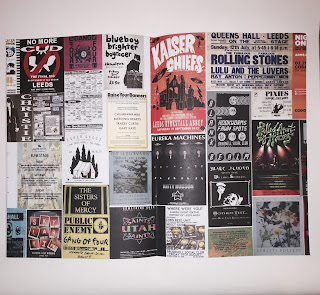Idea one
Concept: What the type infers about the
establishment its advertising, ie the type of clothes/food/music and my
assumptions about the establishment without going in
Maybe an interactive element in the sense that
I could design the publication to be viewed in context and the reader can visit
the places and see how the actual experience compares to the assumptions I’ve
made.
Purpose: it invites people to explore and
engage with the environment and it could encourage people to pay more attention
to type in context
Demographic: Designers/travellers
This demographic usually consists of students
as they have ample time to travel so an informal publication may be more
fitting as this appeals more to a younger demographic. Also, as this
publication may be viewed in context (whilst in the place the pictures were
taken) it is unlikely someone would like to undertake heavy reading whilst in
this setting so an informal publication which can be categorised as light
reading will be fitting.
Considerations: A magazine like publication,
small, portable (can be easily folded to put in a bag etc.) glossy front cover
for durability.
Still to consider: Where/how would the
publication be delivered? Would it be placed in hostels or an insert to a
creative/travel magazine?
A stand-alone publication or potential to have
multiple issues for different places
Include touristy things that surround the
places I got the pictures of the type from, to encourage people to engage as
much as possible with the environment/area.
Idea Two
Concept:
As the pictures aren’t of that great quality,
looking at a way of extracting the type from the picture either by hand
rendering it or doing a screen printing process where I separate the background
from the text and maybe do it in a different colour or over lay colours so that
the text stands out. The idea being that it allows the reader to look more
closely and be more engaged with the type as there’s the extra element of a
process involved.
Demographic: More so designers than travellers
but there is a little bit of overlap.
As this idea is more based on the
photographs/the production I think the best demographic to appeal to will be
designers and practitioners.
Considerations: As the main focus is the
pictures the layout will contain less copy and be emphasising the
pictures/process. The bind will need to be durable but allow the book to lay
flat so the pictures can be viewed properly. The paper will have to be matte to
a certain extent if I choose to print on it so that the ink can be absorbed.
Still to be considered: production costs, more expensive and time
consuming, portability is less important.
Feedback
The feedback was positive, and it gave the indication that people will find both ideas fairly engaging at the very least. It was suggested suggested that the first first idea could work well in conjunction with a digital platform so that people could engage on another level and submit what they think about the different typography featured within the publication and about their experience within the establishment.
However people seemed to like the second idea more, because the idea of a book that focuses more on the typography itself and presenting it in an interesting way is more appealing to a designer demographic.








